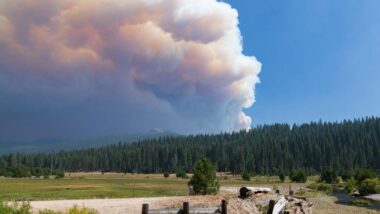Top Class Actions’s website and social media posts use affiliate links. If you make a purchase using such links, we may receive a commission, but it will not result in any additional charges to you. Please review our Affiliate Link Disclosure for more information.
Large blind spots are a hazard and a challenge for tractor-trailer drivers and a source of danger for motorists. Each year, there are an average of a half-million traffic accidents involving a big rig, more than 25 percent of which involve serious injury or death, usually for those in the smaller vehicle.
While these accidents are often the fault of the truck driver, those who operate passenger vehicles or other smaller vehicles can fail to take proper precautions. Being aware of a large truck’s blind spots and developing defensive driving skills can save lives and avoid serious injury.
What is a Blind Spot?
In driver’s education class it’s taught that a blind spot is any place around the vehicle where other vehicles cannot be seen in the mirrors. This is why instructors remind student drivers never to trust their mirrors and to always look when changing lanes or maneuvering in traffic.
While this is certainly important advice for all motorists, it is particularly critical for drivers of large freight trucks, motor homes, and passenger buses. Unless such vehicles are equipped with a rear-view video camera and monitor, there is virtually no way to see everything that is behind it.
What Are Large Blind Spots?
Truckers must contend with four major blind spots:
- directly to the rear
- directly in front (unless it is a cab-over design, which is rare today)
- driver’s side next to the side mirror
- passenger’s side next to the side mirrors
Commercial truck driver training involves learning to recognize these blind spots and checking the surrounding traffic carefully before making turns and lane changes, but other drivers need to be aware of them as well.
If Truckers Are Trained, Why do Accidents Happen?
Due to trucker fatigue, lack of experience or other distractions, a driver may neglect to check his or her blind spots before making a move. However, automobile operators can also make mistakes, such as following or traveling too close to an 18-wheeler.

It is worth noting that while nearly a quarter of trucking accidents involving a passenger car are rear-end collisions, 10 percent are side-swipe mishaps. This is why it pays for auto operators to be aware of a trucker’s large blind spots and avoid them while traveling.
How Can I Avoid a Truck Accident
There are four defensive driving techniques that may save you from injury and possible death:
- Visualize stopping distance. Tailgating a big rig will not get you to your destination any faster, and will increase your risk of a rear-end collision. Driveincontrol.com reminds motorists about the “three-second” rule of following other vehicles (which should be increased in bad weather).
- Visualize stopping distance again. If the shoe is on the other foot and a trucker is tailgating you, take a deep breath, change lanes and let the truck go around you. It is possible that the truck driver may not even see you, since there is a blind spot directly in front of the hood. Remember that an 18-wheeler weighs 30 times more than an automobile, and requires far more stopping distance.
- Change lanes carefully. Do not change lanes in front of a large truck until both of its headlights can be seen in your rearview mirror. This helps to ensure you are not stuck in the front blind spot.
- Pass with care. The right side of a tractor-trailer is the most serious of the large blind spots. Signal well in advance, and pass only on the truck’s left side.
Unfortunately, according to the National Highway Traffic Safety Administration, semi truck crashes are on the rise. Between 2017 and 2018, the number of people involved in large truck crashes rose by more than 12 percent, from 553,000 to 622,000. Additionally, the number of people killed by accidents involving large trucks rose by almost a percent. In 2018, 885 people were killed in these accidents.
Truck Accident Lawsuits
Several lawsuits have been filed against truck drivers for allegedly failing to check their large blind spots due to fatigue or inattention. In 2019, trucking company Werner Enterprises agreed to pay $40.5 million in damages after a 2017 crash involving a Werner truck and driver. $10 million of the award was punitive, and intended to punish the trucking company responsible.
The accident occurred in February 2017, when a truck driver crossed four lanes of traffic and a median before colliding with a civilian vehicle going in the opposite direction. The driver of the vehicle was killed in the head-on crash.
Join A Free Truck Accident Lawsuit Investigation
Truck accidents can result in serious injuries to drivers and their families. A truck accident lawsuit can recover damages to compensate victims and families for associated costs and damages.
If you or a loved one were involved in a truck accident and sustained injuries and damages, you may be eligible to file a lawsuit. Fill out the form on this page for a free case evaluation.
ATTORNEY ADVERTISING
Top Class Actions is a Proud Member of the American Bar Association
LEGAL INFORMATION IS NOT LEGAL ADVICE
Top Class Actions Legal Statement
©2008 – 2024 Top Class Actions® LLC
Various Trademarks held by their respective owners
This website is not intended for viewing or usage by European Union citizens.
Get Help – It’s Free
Join a Free Truck Accident Lawsuit Investigation
If you qualify, an attorney will contact you to discuss the details of your potential case at no charge to you.
PLEASE NOTE: If you want to participate in this investigation, it is imperative that you reply to the law firm if they call or email you. Failing to do so may result in you not getting signed up as a client or getting you dropped as a client.
E-mail any problems with this form to:
Questions@TopClassActions.com.
Oops! We could not locate your form.













